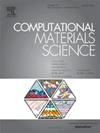磁势垒在二硫化钼中的自旋和谷相关隧穿
IF 3.3
3区 材料科学
Q2 MATERIALS SCIENCE, MULTIDISCIPLINARY
引用次数: 0
摘要
我们研究了磁障作用下单层二硫化钼MoS2中的电子输运。我们的分析采用全波段连续模型来捕捉相关的物理现象。我们关注的是电子能量、磁场强度和势垒的几何特性如何影响传输和电导。我们观察到由磁约束引起的量子干涉效应所产生的尖锐共振隧穿特征。我们研究的一个关键结果是在传导带和价带中发现了不同的共振模式。这些模式与二硫化钼的本征自旋轨道耦合和磁场对时间反转对称性的破坏密切相关。这导致了电子传递中显著的自旋和谷选择性。我们证明了调节外部参数可以精确地控制自旋极化和谷极化电流。我们发现磁势垒可以控制二硫化钼中的电子自旋和谷,使其成为一种有前途的节能自旋电子和谷电子器件平台。本文章由计算机程序翻译,如有差异,请以英文原文为准。

Spin and valley-dependent tunneling in MoS2 through magnetic barrier
We study electron transport in monolayer molybdenum disulfide MoS subjected to a magnetic barrier. Our analysis employs a full-band continuum model to capture the relevant physical phenomena. We focus on how electron energy, magnetic field strength, and the geometric characteristics of the barrier affect the transmission and conductance. We observe sharp resonant tunneling features emerging from quantum interference effects induced by magnetic confinement. A key outcome of our study is the discovery of distinct resonance patterns in the conduction and valence bands. These patterns are closely related to the intrinsic spin–orbit coupling in MoS and the breaking of time-reversal symmetry by the magnetic field. This results in significant spin and valley selectivity in electron transport. We demonstrate that adjusting external parameters precisely controls spin-polarized and valley-polarized currents. We show that a magnetic barrier can control electron spin and valley in MoS, making it a promising platform for energy-efficient spintronic and valleytronic devices.
求助全文
通过发布文献求助,成功后即可免费获取论文全文。
去求助
来源期刊

Computational Materials Science
工程技术-材料科学:综合
CiteScore
6.50
自引率
6.10%
发文量
665
审稿时长
26 days
期刊介绍:
The goal of Computational Materials Science is to report on results that provide new or unique insights into, or significantly expand our understanding of, the properties of materials or phenomena associated with their design, synthesis, processing, characterization, and utilization. To be relevant to the journal, the results should be applied or applicable to specific material systems that are discussed within the submission.
 求助内容:
求助内容: 应助结果提醒方式:
应助结果提醒方式:


